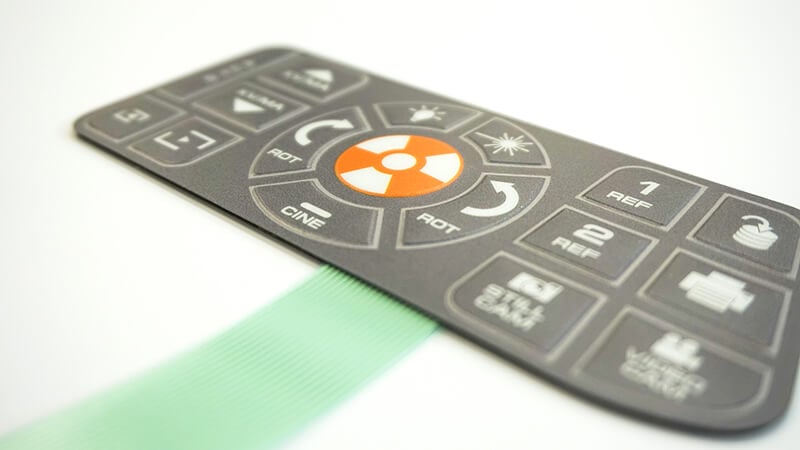The Full Overview to Membrane Switch Technology and Its Applications
How Membrane Layer Changes Add To the Toughness of Electronic Control Panels
Membrane buttons play an important duty in improving the sturdiness of electronic control panels, largely with their multi-layered building which supplies efficient security against ecological elements such as wetness and dirt. The absence of relocating parts considerably lowers the chance of mechanical failures, making membrane layer changes ideal for requiring applications.
Interpretation of Membrane Switches

Membrane layer buttons are developed to be thin and light-weight, making them ideal for applications where area is restricted. They can be made in numerous forms, sizes, and colors, offering adaptability in layout that fulfills visual and useful demands. Additionally, membrane layer buttons can include various innovations, such as responsive responses and LED indicators, enhancing user experience.
Due to their building, membrane buttons are commonly immune to dirt, dampness, and general wear, adding to their toughness in demanding atmospheres. Their seamless design not just promotes very easy cleansing however likewise reduces the danger of mechanical failure, making them a preferred choice for manufacturers looking for trusted customer interfaces in their digital control board.
Protection Against Environmental Factors
The style of membrane changes naturally offers a level of defense versus different environmental aspects, which is vital for preserving capability in difficult conditions - Membrane Switch. These switches are commonly built with layers of flexible products that protect internal components from wetness, dirt, and contaminants. By encapsulating the wiring, membrane layer switches decrease the danger of short circuits and rust, which can dramatically impair efficiency
Furthermore, making use of durable adhesives and sealants during manufacturing enhances their resistance to ecological obstacles. Membrane switches can endure exposure to chemicals and solvents, making them appropriate for markets such as food handling and health care, where health and tidiness are extremely important. Their seamless surface area style additionally avoids the buildup of dust and microorganisms, facilitating much easier cleansing and maintenance.
Temperature level fluctuations are another ecological issue, and membrane layer switches are engineered to work properly throughout a variety of temperature levels (Membrane Switch). This flexibility guarantees that control panels remain functional in various setups, from commercial settings to customer electronic devices
Effect On Individual Communication
User interaction with electronic control panels is substantially affected by the design and performance of membrane layer buttons. These buttons provide a tactile user interface that improves the general user experience, allowing for instinctive navigating and control. Their responsive nature guarantees that users obtain prompt responses upon activation, which is essential for tasks needing precision and performance.
In addition, the smooth surface of membrane switches over assists in easy cleansing and upkeep, advertising individual self-confidence in the reliability of the user interface. This tidiness is particularly crucial in atmospheres where hygiene is critical, such as medical or try this website food processing setups. Additionally, the compact and light-weight layout of membrane layer switches over adds to the visual charm of control panels, urging user involvement with a modern-day and smooth look.
Additionally, the combination of visual aspects, such as printed symbols and backlighting, helps users quickly recognize features, decreasing the learning contour related to new equipment. Consequently, users can operate tools better, leading to raised efficiency and contentment. In summary, membrane switches play a pivotal function in boosting customer interaction by integrating functionality, aesthetic appeals, and ease of usage, eventually causing boosted functional effectiveness.
Design Versatility and Modification
Design adaptability and customization are necessary aspects of membrane layer switches, allowing manufacturers to customize digital control panels to details applications and user demands. This adaptability enables the integration of different layout elements, such as shades, graphics, and textures, which can improve the aesthetic allure and customer involvement of the control board.
Membrane layer switches can be personalized in dimension and form, suiting a wide variety of devices and applications, from industrial equipment to customer electronic devices. This versatility makes certain that manufacturers can produce user-friendly interfaces that line up with user expectations and learn this here now functional needs. Additionally, the ability to incorporate unique attributes such as backlighting or responsive comments additionally boosts use, enabling a much more interactive experience.
In addition, the manufacturing procedure for membrane switches supports the rapid prototyping of designs, allowing producers to repeat and fine-tune their ideas swiftly. This capacity not just speeds up the development visite site timeline yet additionally makes certain that the last product meets particular useful and visual criteria.

Cost-Effectiveness and Longevity
Cost-effectiveness and long life are significant benefits of membrane layer buttons, making them an appealing choice for producers and end-users alike. These switches are commonly cheaper to produce than typical mechanical buttons, mostly due to their simplified manufacturing processes and the reduced variety of parts required. This cost benefit expands not just to preliminary production however additionally to long-lasting functional expenses, as membrane layer switches typically require less upkeep and have a lower failure price.
Moreover, the long life of membrane layer switches over contributes to their general value. Built from resilient products, they are resistant to ecological aspects such as moisture, dirt, and chemicals, which can bring about premature wear in other button types. The lack of relocating parts reduces mechanical failing, permitting membrane layer switches to preserve functionality over prolonged periods.
This longevity is particularly valuable in applications needing regular performance under demanding conditions, such as medical gadgets and commercial tools. Eventually, the mix of cost-effectiveness and long life makes membrane layer switches an economically practical selection for producers, offering trustworthy remedies that hold up against the test of time while enhancing financial factors to consider.
Conclusion
In final thought, membrane buttons substantially improve the resilience of digital control panels with their durable building and construction and protective functions - Membrane Switch. In general, membrane layer switches represent a dependable and affordable choice for improving the long life and functionality of digital control systems.